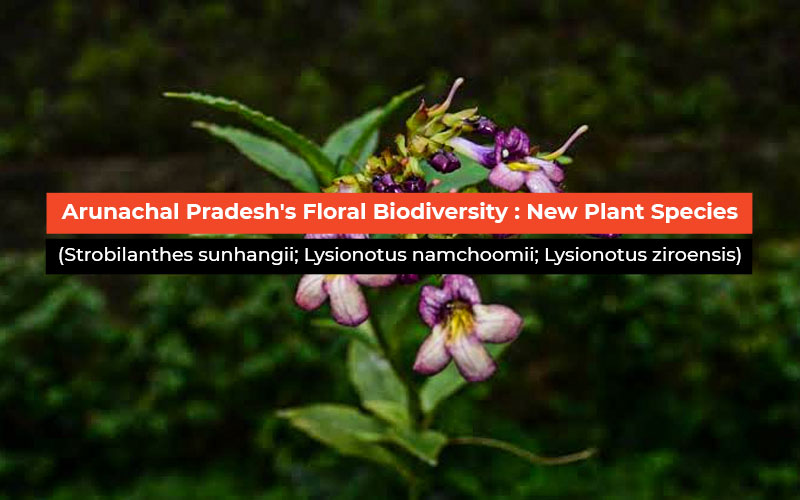
Arunachal Pradesh's Floral Biodiversity: New Plant Species (Strobilanthes sunhangii; Lysionotus namchoomii; Lysionotus ziroensis)
Numerous botanical discoveries have been made in Arunachal Pradesh, a province that is so commonly ignored by mainstream research. This far-flung state in northeastern India has produced a large number of new plant species in recent years, demonstrating its unrealized potential for more research and botanical discoveries in its unexplored regions. These results highlight the necessity for ongoing study and conservation initiatives in addition to adding to our understanding of the distinctive flora of the area. In this blog, let us delve into the fascinating world of botanical discoveries in Arunachal Pradesh, focusing on three remarkable findings in the state: Lysionotus namchoomii, Lysionotus ziroensis, and Strobilanthes sunhangii.
Strobilanthes sunhangii:
The flora catalogue of India has
expanded with the discovery of Strobilanthes sunhangii. This species of plant,
which is a member of the Acanthaceae family, was previously limited to the
Medog county in Tibet, China. It has, however, just been identified in Indian
flora, originating from the type locality in the Pakke Kesang district of
Arunachal Pradesh.
While on expeditions in the Pakke
Kessang area of Arunachal Pradesh, a population of Strobilanthes plants was
discovered by a team of researchers from the Botanical Survey of India,
comprising Krishna Chowlu, Akshath Shenoy and Ambrish Kumar. The researchers
meticulously observed plants in their natural habitat, examined specimens in
the herbarium, and reviewed relevant published material to give a thorough
description, distribution analysis, and colour images for Strobilanthes
sunhangii. In the course of studying Strobilanthes sunhangii, researchers noted
some minor variations in calyx and stamen characteristics compared to those
reported by previous researchers. These variations offer valuable insights into
the species and its unique features, prompting further research and
exploration. The discovery was revolutionary since this species had not been
documented in India before
Strobilanthes sunhangii seems to
thrive in tropical semi-evergreen forest areas at elevations ranging from 1300
to 1600 metres. Its spread spans both China and India, demonstrating the
plant's ability to survive in a variety of settings. Strobilanthes sunhangii is
in jeopardy due to its limited distribution and habitat degradation caused by
anthropogenic activities and natural calamities. The IUCN Criteria classify it
as "endangered," indicating the importance of conservation measures.
The extent of occurrence (EOO) is predicted to be less than 5,000 km2, with a
12 km2 area of occupation (AOO). The challenges this species faces highlight
the importance of ongoing monitoring and conservation efforts.
Strobilanthes sunhangii belongs to the Strobilanthes genus, which is the second-largest in the Acanthaceae family, with over 450 species. These plants are primarily found in the tropical regions of Asia. The genus has 167 species in India, with 41 of them flourishing in Arunachal Pradesh. The difficulty in studying this genus stems from its rare flowering and monocarpic character, which makes species identification difficult. As a result, many Strobilanthes species are still unnamed.
Lysionotus namchoomii:
A new species of epiphytic plant,
Lysionotus namchoomii, was discovered in the Pakke-Kessang district by
scientists from the Botanical Survey of India (BSI) and other foreign research
organisations. Their ground-breaking research, titled "Lysionotus
namchoomii (Gesneriaceae): A New Species from Arunachal Pradesh, India,"
has been published in the esteemed journal Turczaninowia. The new species has
been named after the late Chau Phunkyoo Namchoom, a well-known social reformer
from the Khampti community in Arunachal Pradesh, as a tribute to his unwavering
commitment to healthcare, education, and environmental preservation.
Its epiphytic nature is what distinguishes Lysionotus namchoomii. Epiphytic plants, a common feature of tropical and subtropical woods, are distinguished by their extraordinary capacity to grow on other plants. The unusual adaptability with which the flora in these locations have evolved to flourish in their intricate ecosystems is better understood as a result of this finding. Despite just having recently been discovered, Lysionotus namchoomii is already threatened. According to the International Union for Conservation of Nature's (IUCN) Red List, it is currently listed as "Critically Endangered". The species had been identified only in two places, and there are only 60–100 members of the limited population, which is the reason for this categorization.
Lysionotus ziroensis:
In the same series of expeditions
in Arunachal Pradesh, botanists stumbled upon another botanical wonder,
Lysionotus ziroensis. It is a subshrub that is also epiphytic in nature. It was
named after its type locality, Ziro, from where it was discovered. This
epiphytic subshrub, found in the Lower Subansiri district, offers a glimpse
into the remarkable diversity of Arunachal Pradesh's flora. It is a forest edge
native that grows epiphytically on big trees with hanging branches. When
Procris crenata and mosses are present, the roots of this plant take hold of
damp branch clefts. As of right now, the species is restricted to Ziro, Lower
Subansiri district, where it can be found between 2300 and 2430 metres above sea
level.
Despite its unique habitat,
Lysionotus ziroensis also faces a challenging future. There are just
approximately 25 mature specimens of this species found in its type locality,
indicating an extremely small population. Considering the impending dangers of
deforestation and road construction in the area, this puts it at grave risk of
being extinct. These difficulties are reflected in the IUCN Red List's
tentative classification of this species as "data deficient," which
emphasises the need for more research and conservation initiatives in similar
areas throughout Northeastern India.
In conclusion, the amazing
botanical finds in Arunachal Pradesh highlight how crucial it is to keep
exploring unexplored areas in order to find nature's hidden gems. Not only are
these results astounding in and of themselves, but they also show how much
biodiversity there is in this far-flung region of India that still has to be
discovered and recognised. We must take action to protect and preserve our
forest and vegetation, which are home to hundreds of exotic and endemic species
through continued exploration. As we continue to explore this region, we can
only imagine the countless more discoveries that await us in the lush forests
and uncharted territories of Arunachal Pradesh.
Disclaimer: The opinions expressed in this article are those of the author's. They do not purport to reflect the opinions or views of The Critical Script or its editor.

Newsletter!!!
Subscribe to our weekly Newsletter and stay tuned.

















Related Comments